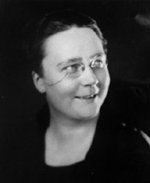
But has the work of Sayers stood the test of time? Her earlier novels are relatively straightforward mysteries, great fun to read, but often implausibly plotted and peopled by entertaining but two-dimensional characters. Her amateur detective, Lord Peter Wimsey, is a foppish figure inspired by PG Wodehouse’s Bertie Wooster. However, both Wimsey and the stories grow darker and more mature as the series progresses. In her later work, she pushed the boundaries of the genre creating original and thought-provoking work that has put her up in the stratosphere, way above more ordinary crime authors. The following five novels are among her best and were all written within the space of just five years.
The isolated village of Fenchurch St Paul in the East Anglian Fenlands becomes the central character in this haunting, atmospheric novel. Lord Peter Wimsey is stranded in this village following a car crash and gets involved in a scandal involving the death of the local squire, a major jewel theft, escaped convicts and unidentified corpses. And, of course, the ringing of change bells. Contemporary critics branded it a ‘manual of bell-ringing’, but this eccentricity has become one of the most memorable aspects of the book, along with the vividly drawn local characters, such as village simpleton Potty Peake or the Rector and his wife. This is the first book in which the author hints that sometimes it is best to leave a mystery unsolved, because the solution may cause more pain than relief.
Buy now on Amazon
Set in the pretentious world of advertising, this is a terrific precursor to Mad Men, and by far the funniest of Dorothy L Sayers’ novels. When upwardly mobile young copywriter Victor Dean falls to his death on a staircase at Pym’s Publicity, Wimsey joins the advertising agency under a pseudonym to try and solve the case. It appears that the agency may have been used as a base for drug-dealing, so Wimsey starts leading a dangerous double life in order to unravel the mystery. Although Sayers herself was not happy with what she called the ‘fashionable dope-traffic’ aspect of the story, the descriptions of the rumours, creative rivalry and blatant lies of the advertising world are spot-on.
Buy now on Amazon
This is the first Sayers book to introduce Harriet Vane, a successful author and the sparring partner/love interest for Lord Peter Wimsey. It is also the first one to raise social issues far beyond the scope of the genre, marking Sayers’ promotion to the premier league of crime fiction. Harriet is accused of poisoning her former lover, the jury and public opinion cannot help but be skeptical of her ‘immoral’ ways, but Wimsey is convinced of her innocence. He has to work against the clock before the retrial to find the real killer. The opening chapter is a masterpiece of rhetoric, containing the judge’s summary of the facts of the case, clearly aimed at prejudicing the jury against her, and expressing the mainstream views of the period. This unfair and hostile statement stands as a constant reminder that speculation and gossip have no place in a murder trial, even though we may initially doubt Harriet’s motives.
Buy now on Amazon
Harriet is recovering from the tribulations of her trial on a walking holiday on the Devon coast when she comes across a body on an isolated rock by the shore. The man’s throat has been slashed and blood is still flowing. Quick-witted and practical, she manages to take some pictures before the tide comes in to sweep the body away. Although she is very briefly considered a suspect herself, given her previous history, she soon joins the police and Lord Wimsey to investigate the case. The murder plot seems unnecessarily convoluted – but maybe Sayers was mocking the impossibly complex puzzles and explanations written by her contemporaries. Harriet and Peter have to reformulate their hypothesis again and again. Yet, ultimately, it’s not a mere puzzle to be solved purely through intellect, and that is the overriding sentiment you are left with after reading the novel. It’s a real murder, with sordid, pitiable details, putting a brutal end to a real person. Well, fictionally, anyway.
Buy now on Amazon
Perhaps one of my favourite books of any genre, this is the book about which Sayers herself confessed: “It is the only book I’ve written embodying any kind of a ‘moral’ and I do feel rather passionately about this business of the integrity of the mind.” This book is even better on a second reading, as there is so much humour, conflict of ideas and loving descriptions of Oxford which you might otherwise miss. There is no murder at Harriet Vane’s college reunion in Oxford, but plenty of poison pen letters and vandalism. We are exposed here to the vicious gossip and intrigue of a closed community and feel, as Harriet does, the strong pull yet gradual disenchantment with the romance of collegiate life and the myth of having it all.
Buy now on Amazon
And so back to our original question – does the author’s work stand the test of time? Unlike other Golden Age authors, the xenephobic and classist views that appeared were traits of her more loathsome characters rather than of the author herself. The slow pace may be a little trying to modern readers. I have to admit skipping over some interminable passages describing cricket or code-breaking, but there is so much more than plot to enjoy in these richly textured tales. Sayers’ style may not be to everyone’s taste. Erudite and proud of it, she liked in-jokes, literary allusions and foreign language quotes. However, if you accept this cleverness as sheer exuberance rather than showing off you’ll succumb to the charms of her writing. After reading a few of her wittier works you may find other writers seem immature in comparison.
Watch for our look at Dorothy L Sayers and the Fenland links in her books, also part of Classics in September 2013.